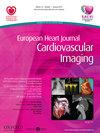3D substrate complexity analysis using cardiac MRI predicts ICD therapy in post-infarct ventricular tachycardia
引用次数: 0
Abstract
Abstract Funding Acknowledgements Type of funding sources: Foundation. Main funding source(s): EACVI, Netherlands Heart Institute. Background Implantable cardiac defibrillator (ICD) implantation can protect against sudden cardiac death (SCD) after a myocardial infarction. However, relatively few patients with an ICD experience a life-threatening arrhythmic event. Imaging studies have proposed metrics based on 2D analysis of late gadolinium enhancement (LGE) characteristics to predict post-infarct malignant arrhythmias and improve SCD risk assessment. However, given the intrinsic 3D nature of the electrical pathways through the infarcted regions, 3D reconstructions of the scar substrate from LGE imaging may be required to fully characterize the pro-arrhythmic nature of the scar substrate. Aim To evaluate the accuracy of LGE based 3D metrics such as conduction corridors (regions of borderzone (BZ) surrounded by scar core) and 3D interface surfaces (boundaries between scar and myocardium) towards predicting ICD therapy. Methods ADAS LV and custom-made software was used to generate 3D patient-specific ventricular models in a prospective cohort of post-infarct patients (n=40) having undergone LGE imaging pre-ICD implantation. The extent of variation in scar-characteristics was evaluated in ADAS by quantifying the BZ, scar core, the number and weight of conduction corridors i.e. BZ surrounded by scar core. Custom-written scripts were used to calculate metrics describing the 3D topology of the scar substrate, specifically the interface area between myocardium and total enhancement (BZ+core), and the interface between BZ and core. These metrics were compared with ICD therapy during follow-up. Results Total corridors were comparable between both groups (6.53 ± 7.9 vs. 4.6 ± 4, p = .38). Corridor weight demonstrated a trend towards higher mass in the event group (2.7 ± 2.1g vs. 1.6 ± 1.4g, p = .06). Patients with an event (n=17) had higher myocardium-total enhancement interface (103.8±35.1cm2 vs. 77.4±33.7cm2, p = .021) and BZ-core interface (76±27.5cm2 vs. 55.2±27.6cm2, p = .024). Cox-regression demonstrated a significant independent association of myocardium-total enhancement interface with an event (HR 2.79; 1.44–5.44, p < .01). Kaplan-Meier analysis (Figure 1) showed a significantly higher event rate in patients with an interface area between myocardium-total enhancement of more than 72cm2 and BZ-core more than 42.3cm2. Conclusion These results demonstrate that patients with appropriate device therapy had larger myocardium-total enhancement and BZ-core surface interface areas. Conceptually, the BZ-core interface could be considered to be related to the reentrant circuit path-length whilst the myocardium-total enhancement interface reflects the surfaces most-likely to initiate unidirectional block, both of which can be consider pro-arrhythmic substrates. These findings emphasize the importance of visualizing and thereby characterizing substrate as a 3D entity instead of the currently applied 2D approach to facilitate early identification of high-risk patients.3D底物复杂性分析使用心脏MRI预测ICD治疗梗死后室性心动过速
资金来源类型:基金会。主要资金来源:EACVI,荷兰心脏研究所。背景植入式心脏除颤器(ICD)植入术可预防心肌梗死后心脏性猝死(SCD)。然而,相对较少的ICD患者经历危及生命的心律失常事件。影像学研究提出了基于晚期钆增强(LGE)特征二维分析的指标,以预测梗死后恶性心律失常并改善SCD风险评估。然而,考虑到通过梗死区域的电通路的固有3D性质,可能需要通过LGE成像对疤痕基底进行3D重建,以充分表征疤痕基底的促心律失常性质。目的评价基于LGE的三维指标,如传导走廊(疤痕核心包围的边界区区域)和三维界面(疤痕与心肌之间的边界)对预测ICD治疗的准确性。方法采用ADAS LV和定制软件对40例接受LGE成像预icd植入的梗死后患者进行前瞻性队列研究,生成患者特异性三维心室模型。在ADAS中,通过量化BZ、疤痕核、被疤痕核包围的传导走廊(即BZ)的数量和权重来评估疤痕特征的变化程度。使用自定义编写的脚本计算描述疤痕基底的三维拓扑的指标,特别是心肌和总增强(BZ+核心)之间的界面面积,以及BZ和核心之间的界面。在随访期间将这些指标与ICD治疗进行比较。结果两组间总廊道具有可比性(6.53±7.9 vs. 4.6±4,p = 0.38)。事件组的走廊重量有增大的趋势(2.7±2.1g vs. 1.6±1.4g, p = 0.06)。事件组(n=17)患者心肌-总增强界面(103.8±35.1cm2 vs. 77.4±33.7cm2, p = 0.021)和BZ-core界面(76±27.5cm2 vs. 55.2±27.6cm2, p = 0.024)较高。cox回归显示心肌-总增强界面与事件有显著的独立关联(HR 2.79;1.44-5.44, p <. 01)。Kaplan-Meier分析(图1)显示,心肌总增强大于72cm2与BZ-core界面面积大于42cm2的患者,事件发生率明显更高。结论经适当器械治疗的患者心肌总增强和bz核表面界面面积增大。从概念上讲,BZ-core界面可以被认为与可重入回路路径长度有关,而心肌-全增强界面反映了最可能引发单向阻滞的表面,两者都可以被认为是促心律失常的底物。这些发现强调了可视化的重要性,从而将底物表征为3D实体,而不是目前应用的2D方法,以促进早期识别高风险患者。
本文章由计算机程序翻译,如有差异,请以英文原文为准。
求助全文
约1分钟内获得全文
求助全文

 求助内容:
求助内容: 应助结果提醒方式:
应助结果提醒方式:


